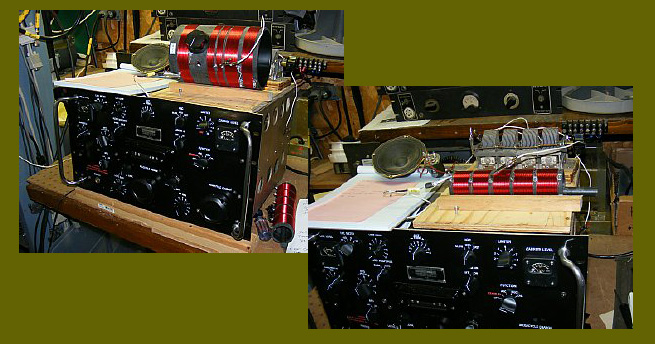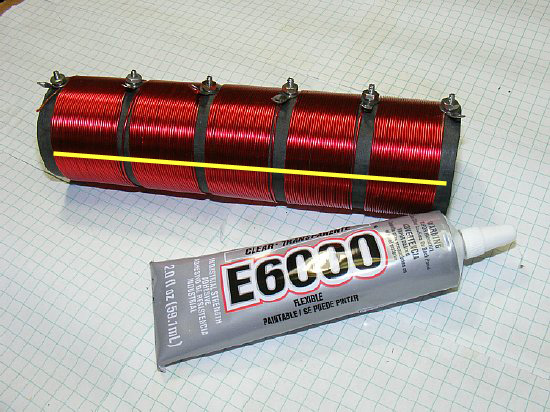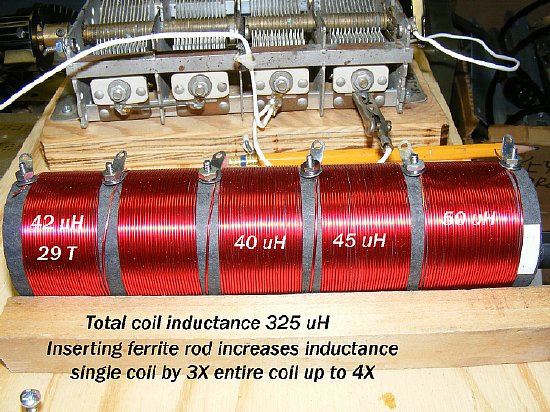Low Frequency Ferrite Rod Tuning Coil for the R-390A
Additional info on using the R-390A below 500 kcs using a variometer for antenna matching.

Shown above two different coils for matching an antenna to the R-390A below 500 kcs. On these pages we will discuss the coil on the right that is tuned with a ferrite rod.

The coil and capacitor provide quite a tuning range for matching the antenna to the input of the mixer at E209 for R-390A reception below 500 kcs. In most of my testing just using the coil to match a random wire antenna provided a close match and provided sufficient RF gain and aided in selectivity in the 300 to 500 kcs range.
A simple alligator clip and capacitor provide mixer input to test point E209 from the antenna coil.
A trip to Lowe's will provide you with a ABS plastic pipe with a 1-7/8 inch diameter. Sanding the pipe will aid in holding the windings as you wind the coil.
After
winding several coils I decided that using 4-40 hardware was the best
solution for tap points on the coil. The coil in front just used a twist
in the wire to form a soldering loop. When winding the coil when you reach
the 4-40 bolt just scrape off some of the enamel and wrap once around
the bolt and continue. The neat feature of the bolts is that you can lay
the project down half way through the coil because the 4-40 bolts secure
the windings as you go along and you can take a break from the strenuous
exercise.
Ready for winding the coil has been sanded and is 7 1/4 inches in length.
When
you reach the bolt, strip the wire and then do a single wrap and continue
the winding. If you are exhausted after the first winding take a break.
But if you want to do some real radioing then man up and continue with
the project.
Go to the ARRL site and order a "Coil Winding" calculator. This will help you with "What If" questions such as change of wire size, number of windings, diameter changes etc.
My
overall plan for the coil was to utilize a ferrite rod inserted in the
coil to vary the inductance. Using the coil taps and the rod provides
a large tuning range.There are plenty of distributors of ferrite rod on
ePay and several US distributors. The material type of rod is not that
critical in this particular application. Type 61 material is OK.
https://www.surplussales.com/inductors/FerRods/FerRods.html
http://www.amidoncorp.com/r61-025-400/
TIP: A 4 inch rod is OK as you can either use
it by itself or glue another rod to the end to give you 8 inches. Also
if you break the rod you can glue it back together. Mark the rod in increments
for logging your tuner settings with a Brother Label maker.
By
marking the rod you can log tuning settings for future reference.
Video
of R-390A low frequency tuning via coil and rod.
Most of my tests using several random wire antennas worked very well without using a capacitor across the coil. I do use this cap in a lot of antenna tuning situations on other bands . The alligator clip selects different values. Handy when you are doing real radioing.
Repair any broken rod with Super Glue. If it is a tight joint performance is not degraded.
When gluing two 4 inch rods together end to end to make a longer rod use JB Weld - sand the ends with 400 sandpaper very light for good adhesion of the epoxy.

When gluing rods end to end use 6 minute JB Weld.

When the fear of loose windings keeps you awake at night apply a little E6000 across the coil windings DO NOT cover the entire coil as it will effect the Q - - just do a couple of narrow strips across the coil 90 degrees to the windings.

Coil
length is 7-1/4 long. Inserting the ferrite rod increases the inductance.

TIP: Need more inductance to put in series with your tunable coil for use on a lower frequency that is out of range of the home brew coil? Use a 2.5 mH choke - you could even tap it in between the windings(see arrows) to select smaller inductance values. BUT the Q will be lower than the larger size coils which you can fabricate and beside when you wind the larger coils you are doing some real radioing.
